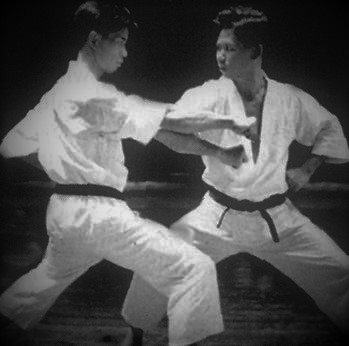To this day many people confuse 分解 and 応用.
I have published a lot about this in the past, however, I decided to reiterate
this important point due to this largely ‘on-going misunderstanding’/
‘misconception’. To confirm, I need to stress that ‘this article specifically
applies to the budo/bujutsu form of Shotokan’ and not necessarily other types
of karate. Indeed, it is not uncommon for other Ryuha and Kaiha to utilize
different terminology and approaches to training. Irrespective, I hope this
article is still a useful read regardless of your background.
 |
| In the above two photos Funakoshi Gigo Sensei is demonstrating Bunkai. |
OK, so firstly, I want everyone to closely look at the kanji
and meaning of both.
分解 (ぶんかい): Bunkai = ‘analysis’,
‘break down’, ‘dismantle’, ‘decomposition’, etc.
応用 (おうよう): Oyo = ‘application’.
As you can see, the meanings are very different, BUNKAI is about breaking apart/dissecting things; whereas, OYO is about ‘pragmatic application’—at least in the case of those seeking effective karate; that is, 武術空手 (bujutsu karate).
If you have seen the ‘bunkai’ in Nakayama Masatoshi Sensei’s
publications, hopefully you understand the aforementioned points. Otherwise, it
would suggest that “…you believe Nakayama Sensei thought/believed he was
demonstrating oyo”. This premise would require one to believe that ‘Nakayama
Sensei had no idea about effective karate and unarmed fighting in general’,
which is irrefutably incorrect.
This point, by itself, draws a line in the sand between
bunkai and oyo.
So what is the point of bunkai in Shotokan if it’s not for
real fighting? Please forgive me for repeating past articles, but, what I am
about to say about this topic cannot be elucidated enough.
Breaking down the kata, that is bunkai, is literally for learning and refining kata movements and positions: “…for precise kihon execution”. Remember, the key technical characteristic of Karate is KIME. With that fundamental point in mind, Nakayama Sensei wrote "Irrespective of similarities in movement, anything without kime is not or ceases to be karate".
Conversely, oyo is using the waza and/or combative
principles in the respective kata for practical self-defense.
Let’s reverse engineer how we look at this. Imagine if
Nakayama Sensei had oyo demonstrated in his kata publications. The clarity of
movements and positions would certainly be blurred and, in many cases, he would
have probably caused a deterioration in people’s technical development:
especially outside Japan where karate was in its comparative infancy and
largely misunderstood.
Also, there’s two other major and interrelated factors:
safety and responsibility. Most of the oyo from kata is utterly brutal. They
are not about ‘fighting fairly’; rather, they are about life and death survival
(in the case of an ‘unprovoked and life threatening assault’, which literally
requires drastic countermeasures). Accordingly, in this desperate position,
there are no rules and the oyo of karate reflects this.
With this explanation, I think the elements of ‘safety’ and
‘responsibility’ do not need to be spelled out. It reminds me of the old adage:
“When the student is ready the master will appear”.
I’d like to add a little to this by saying something that
might actually shock some readers. I actually really appreciate the bunkai in
‘Best Karate’ (Volumes five to 11), also Nakayama Sensei’s videos. That is
because besides learning, in the dojo, "...this bunkai clarifies accurate initiations,
trajectories and completed waza when performing the kata as a solo drill".
When I first came to Japan in 1993 I noticed the beginners classes, when learning a new kata, would be also taught this 'Best Karate' -like bunkai. At the time I scoffed at the how unrealistic it is. Later, however, I realized it was 'a tool used for better and faster learning of each kata'; furthermore, as I’ve explained above—no one has ever thought of this practice as being ‘the oyo’. After a little reflection, I found that this "...is yet another common gap between us Western and Japanese karateka". Moreover, the lesser of these gaps results in far better karate.
Lastly, I’d like to say that the next time you hear someone
mocking Shotokan bunkai—you will now know—‘they simply do not know what they’re
talking about’ (or they have learned 'sports Shotokan' only). Also, when you
watch one of Nakayama Sensei’s videos or read his books, you will better see
the kata movements and positions, via this ‘bunkai’ which, of course, makes them valuable! I only have one criticism
of the videos… The music! I feel like if I’m seen, through my living rooms
window (with that music playing loud enough) my neighbors will probably think that I’m
watching a different kind of movie!!
Jokes aside, via ‘knowing the difference between bunkai and
oyo’—and training them with this correct understanding—“..both one’s
fundamental actions will improve, and also one’s street effectiveness”.
This brings me to Nakayama Sensei’s ‘Practical Karate’ series of books and self defense videos… This is a completely different ‘can of worms’ and has a very commercial story behind it. Accordingly, I will cover that in my next article. Until then, greetings from chilly Kyushu, Japan.
押忍!!

No comments:
Post a Comment